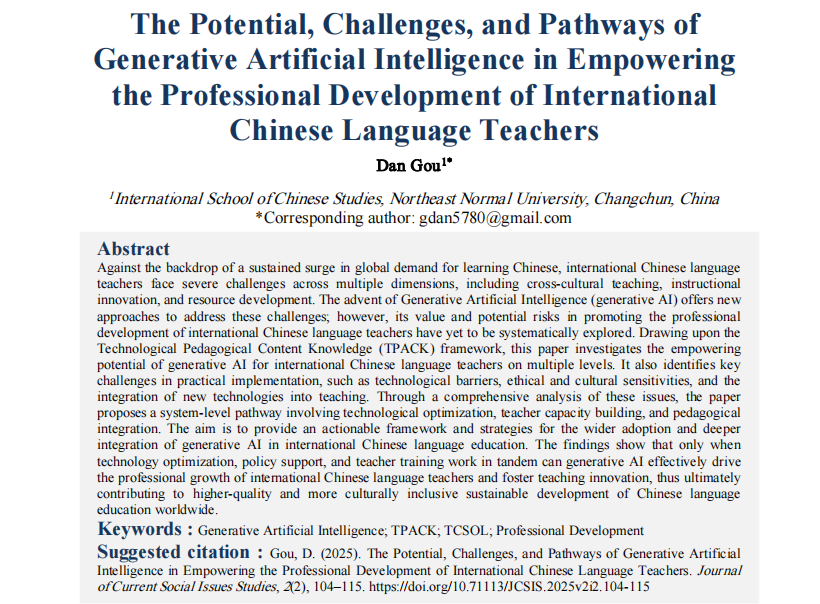The Potential, Challenges, and Pathways of Generative Artificial Intelligence in Empowering the Professional Development of International Chinese Language Teachers
DOI:
https://doi.org/10.71113/JCSIS.2025v2i2.104-115Keywords:
TPACK, Generative Artificial Intelligence, TCSOL, Professional DevelopmentAbstract
Against the backdrop of a sustained surge in global demand for learning Chinese, international Chinese language teachers face severe challenges across multiple dimensions, including cross-cultural teaching, instructional innovation, and resource development. The advent of Generative Artificial Intelligence (generative AI) offers new approaches to address these challenges; however, its value and potential risks in promoting the professional development of international Chinese language teachers have yet to be systematically explored. Drawing upon the Technological Pedagogical Content Knowledge (TPACK) framework, this paper investigates the empowering potential of generative AI for international Chinese language teachers on multiple levels. It also identifies key challenges in practical implementation, such as technological barriers, ethical and cultural sensitivities, and the integration of new technologies into teaching. Through a comprehensive analysis of these issues, the paper proposes a system-level pathway involving technological optimization, teacher capacity building, and pedagogical integration. The aim is to provide an actionable framework and strategies for the wider adoption and deeper integration of generative AI in international Chinese language education. The findings show that only when technology optimization, policy support, and teacher training work in tandem can generative AI effectively drive the professional growth of international Chinese language teachers and foster teaching innovation, thus ultimately contributing to higher-quality and more culturally inclusive sustainable development of Chinese language education worldwide.
References
[1]Alsheikhidris, M. A. A. (2020). Challenges for moving Chinese language courses online. Education and quarterly reviews, 3(3). https://ssrn.com/abstract=3649392
[2]Angeli, C., & Valanides, N. (2005). Preservice elementary teachers as information and communication technology designers: An instructional systems design model based on an expanded view of pedagogical content knowledge. Journal of computer assisted learning, 21(4), 292-302. https://doi.org/10.1111/j.1365-2729.2005.00135.x
[3]Cai, Q. Y. W. (2022). Creating and applying Artificial Intelligence teaching materials for online courses: Review of student teacher skills when teaching Chinese as a foreign language. Chinese Language Teaching Methodology and Technology, 5(1), 47. https://engagedscholarship.csuohio.edu/cltmt/vol5/iss1/4
[4]Chen, L., Chen, P., & Lin, Z. (2020). Artificial intelligence in education: A review. Ieee Access, 8, 75264-75278. https://doi.org/10.1109/ACCESS.2020.2988510
[5]Chen, Z. (2015). Challenges of teaching Chinese in Australian schools: Lesson from beginning teacher-researchers. Journal of Language Teaching and Research, 933-942. https://doi.org/10.17507/jltr.0605.04
[6]Fitria, T. N. (2021). Artificial intelligence (AI) in education: Using AI tools for teaching and learning process. In Prosiding Seminar Nasional & Call for Paper STIE AAS (Vol. 4, No. 1, pp. 134-147). https://prosiding.stie-aas.ac.id/index.php/prosenas/article/view/106
[7]Holmes, W., & Tuomi, I. (2022). State of the art and practice in AI in education. European Journal of Education, 57(4), 542-570. https://doi.org/10.1111/ejed.12533
[8]Holmes, W., Porayska-Pomsta, K., Holstein, K., Sutherland, E., Baker, T., Shum, S. B., ... & Koedinger, K. R. (2022). Ethics of AI in education: Towards a community-wide framework. International Journal of Artificial Intelligence in Education, 1-23. https://doi.org/10.1007/s40593-021-00239-1
[9]Koehler, M. J., & Mishra, P. (2005). What happens when teachers design educational technology? The development of technological pedagogical content knowledge. Journal of educational computing research, 32(2), 131-152. https://doi.org/10.2190/0EW7-01WB-BKHL-QDYV
[10]Koehler, M. J., Shin, T. S., & Mishra, P. (2012). How do we measure TPACK? Let me count the ways. In Educational technology, teacher knowledge, and classroom impact: A research handbook on frameworks and approaches (pp. 16-31). IGI Global. https://doi.org/10.4018/978-1-60960-750-0.ch002
[11]Liao, W., Yuan, R., & Zhang, H. (2017). Chinese language teachers’ challenges in teaching in US public schools: A dynamic portrayal. The Asia-Pacific Education Researcher, 26, 369-381. https://doi.org/10.1007/s40299-017-0356-z
[12]Limna, P., Jakwatanatham, S., Siripipattanakul, S., Kaewpuang, P., & Sriboonruang, P. (2022). A review of artificial intelligence (AI) in education during the digital era. Advance Knowledge for Executives, 1(1), 1-9. https://ssrn.com/abstract=4160798
[13]Niess, M. L. (2005). Preparing teachers to teach science and mathematics with technology: Developing a technology pedagogical content knowledge. Teaching and teacher education, 21(5), 509-523. https://doi.org/10.1016/j.tate.2005.03.006
[14]Pedro, F., Subosa, M., Rivas, A., & Valverde, P. (2019). Artificial intelligence in education: Challenges and opportunities for sustainable development. https://hdl.handle.net/20.500.12799/6533
[15]Pierson, M. E. (2001). Technology integration practice as a function of pedagogical expertise. Journal of research on computing in education, 33(4), 413-430. https://doi.org/10.1080/08886504.2001.10782325
[16]Schiff, D. (2022). Education for AI, not AI for education: The role of education and ethics in national AI policy strategies. International Journal of Artificial Intelligence in Education, 32(3), 527-563. https://doi.org/10.1007/s40593-021-00270-2
[17]Selwyn, N. (2022). The future of AI and education: Some cautionary notes. European Journal of Education, 57(4), 620-631. https://doi.org/10.1111/ejed.12532
[18]Srinivasa, K. G., Kurni, M., & Saritha, K. (2022). Harnessing the Power of AI to Education. In Learning, teaching, and assessment methods for contemporary learners: pedagogy for the digital generation (pp. 311-342). Singapore: Springer Nature Singapore. https://doi.org/10.1007/978-981-19-6734-4_13
[19]Tahiru, F. (2021). AI in education: A systematic literature review. Journal of Cases on Information Technology (JCIT), 23(1), 1-20. https://doi.org/10.4018/JCIT.2021010101
[20]Xu, H. (2012). Challenges native Chinese teachers face in teaching Chinese as a foreign language to non-native Chinese students in US classrooms. https://digitalcommons.unl.edu/teachlearnstudent/20/
[21]Ye, H. (2024). Effectiveness of ChatGPT-assisted oral corrective feedback for international Chinese language teachers (Master’s thesis, Nanjing University of Information Science and Technology). https://link.cnki.net/doi/10.27248/d.cnki.gnjqc.2024.001699
[22]Yingsoon, G. Y. (2021). Using AI Technology to Support Speaking Skill Development for the Teaching of Chinese as a Foreign Language. In Multidisciplinary Functions of Blockchain Technology in AI and IoT Applications (pp. 209-227). IGI Global. https://doi.org/10.4018/978-1-7998-5876-8.ch010
[23]Yue, Y. (2017). Teaching Chinese in K–12 schools in the United States: What are the challenges?. Foreign Language Annals, 50(3), 601-620. https://doi.org/10.1111/flan.12277
[24]Zhai, X., Chu, X., Chai, C. S., Jong, M. S. Y., Istenic, A., Spector, M., ... & Li, Y. (2021). A Review of Artificial Intelligence (AI) in Education from 2010 to 2020. Complexity, 2021(1), 8812542. https://doi.org/10.1155/2021/8812542

Downloads
Published
How to Cite
Issue
Section
License
Copyright (c) 2025 Dan Gou

This work is licensed under a Creative Commons Attribution 4.0 International License.





















